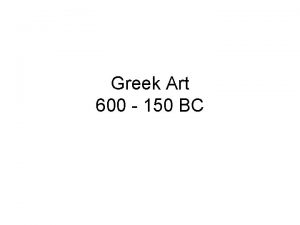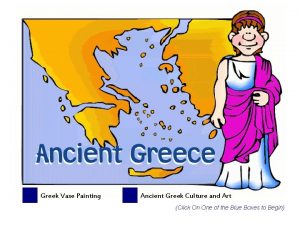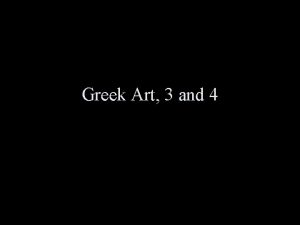Greek Art and Culture Greek Art and Culture






- Slides: 6

Greek Art and Culture

Greek Art and Culture n n n n Concerned with creating the perfect individual Balance between the intellectual and physical (beauty and harmony) Human form was focal point of art Greeks encouraged all forms of art Broken into three periods -Archaic 600 -480 BCE -Classic 480 -323 BCE -Hellenistic 323 -150 BCE

Greek Sculpture Pre-Archaic-Rigid, did not represent real people n Archaic-Less natural and realistic, more idealized, from observation n Classic- Arts flourished after warworked in bronze-very natural-still a bit rigid and severe n Hellenistic- Began after a war disrupted Classical Greece-more concerned with action and emotion n

The Kritios Boy n n n n 480 BCE Marble 3’ 10” Late Archaic/Early Classic Period Acropolis Museum, Athens -Amazing because he actually stands-not held by a block -Arms are free, not bound by part of the original stone -Weight rest mainly on the left leg- relaxed stance -contrapposto- Technique of sculpting the human figure in a pose that puts the weight of the body in balance. Weight is on one leg with shoulders and hips in counterbalance of each other naturally so that the figure does not fall over. -Shows that artist understood that different body parts work as a system -Brings the sculpture to life

Charioteer of Delphi n n n n 470 BCE Bronze Classic Period 71” Archaeological Museum, Delphi Found 1896 -originally stood on chariot drawn by four horses - The sculpture depicts the driver of the chariot race at the moment when he presents his chariot and horses to the spectators in recognition of his victory. - meant to honor Apollo -bronze cast in section and then put together -inclined slightly to one side -left arm missing

Nike of Samothrace 190 BCE Hellenistic Period Marble 8’ The Louvre, Paris n forward movement n Right arm was forward but they were never recovered n notable for its naturalistic pose and for the rendering of the figure's draped garments n Fun Fact- The Rolls Royce radiator figurine, Spirit of Ecstasy, is based on the Nike n Probably celebrating a naval victory n Probably stood on the prow of a ship overlooking the Sanctuary of the n











